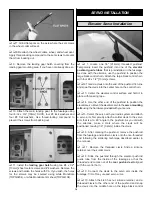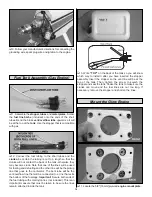
Dependable, redundant and fail-safe battery systems
are recommended.
The use of anti-glitch devices for long leads is recommended.
There is no maximum engine displacement limit, as it is the
position of this body that an underpowered aircraft presents
a greater danger than an overpowered aircraft. However, the
selections of engine size relative to airframe strength and
power loading mandates good discretionary judgment by
the designer and builder. Current AMA maximums for
engine displacement are 6.0 cu in for two-stroke and 9.6 cu
in for four-stroke engines. These maximums apply only to
AMA Sanction competition events such as 511, 512, 515
and 520. All non competition events should be sanctioned
as Class “C” events, in which these engine size maximums
do not apply.
Generally, it is recommended that no attempt should be
made to fly a radio controlled model aircraft with a gas
engine in which the model aircraft weight would exceed
twelve (12) pounds per cubic inch of engine displacement
(underpowered), or be less than five (5) pounds per cubic
inch of engine displacement (overpowered). Example:
Using a 3 cu in engine, a model would likely be
underpowered at an aircraft weight greater than 36 pounds.
With the same engine, an aircraft weighing less than 15
pounds would likely be overpowered.
Servo arms and control horns should be rated heavy-duty.
Glass filled servo arms and control horns are
highly recommended.
Control surface linkages are listed in order of preference:
1. Cable system (pull-pull). A tiller bar is highly recommended
along with necessary bracing.
2. Arrow shaft, fiberglass or aluminum, 1/4" [6.4mm] or 5/16"
[8mm] O.D. bracing every six (6) to ten (10) inches is highly
recommended.
3. Tube-in-tube (nyrod). Bracing every few inches is highly
recommended. Inner tube should be totally enclosed in
outer tube.
4. Hardwood dowel, 3/8" [9.5mm] O.D. Bracing every six (6)
to ten (10) inches is highly recommended.
Hinges should be rated heavy-duty and manufactured
primarily for use in giant-sized aircraft. Homemade and
original design hinges are acceptable if determined to be
adequate for the intended use.
Clevis (steel, excluding heavy-duty ball links) and
attachment hardware should be heavy-duty 4-40 threaded
rod type. 2-56 threaded size rod is acceptable for some
applications (e.g. throttle). Clevises must have lock nuts and
sleeve (fuel tubing) or spring keepers.
Propeller tips should be painted or colored in a visible and
contrasting manner to increase the visibility of the propeller
tip arc.
❏
1. Fuelproof all areas exposed to fuel or exhaust
residue such as the cowl ring, cowl mounting blocks,
wing saddle area, etc.
❏
2. Check the C.G. according to the measurements
provided in the manual.
❏
3. Be certain the battery and receiver are securely
mounted in the fuse. Simply stuffing them into place
with foam rubber is not sufficient.
❏
4. Extend your receiver antenna and make sure it has a
strain relief inside the fuselage to keep tension off the
solder joint inside the receiver.
❏
5. Balance your model
laterally as explained in
the instructions.
❏
6. Use thread-locking compound to secure critical
fasteners such as the set screws that hold the wheel
axles to the struts, screws that hold the carburetor arm
(if applicable), screw-lock pushrod connectors, etc.
❏
7. Add a drop of oil to the axles so the wheels will
turn freely.
❏
8. Make sure all hinges are securely glued in place.
❏
9. Reinforce holes for wood screws with thin CA where
appropriate (servo mounting screws, cowl mounting
screws, etc.).
❏
10. Confirm that all controls operate in the correct direction
and the throws are set up according to the manual.
❏
11. Make sure there are silicone retainers on all the
clevises and that all servo arms are secured to the
servos with the screws included with your radio.
❏
12. Secure connections between servo wires and
Y-connectors or servo extensions, and the connection
between your battery pack and the on/off switch with
vinyl tape, heat-shrink tubing or special clips suitable
for that purpose.
❏
13. Make sure any servo extension cords you may have
used do not interfere with other systems (servo arms,
pushrods, etc.).
❏
14. Secure the pressure tap (if used) to the muffler with
high temp RTV silicone, thread-locking compound or
J.B. Weld.
❏
15. Make sure the fuel lines are connected and are
not kinked.
During the last few moments of preparation your mind may
be elsewhere anticipating the excitement of the first flight.
Because of this, you may be more likely to overlook certain
checks and procedures that should be performed before the
model is flown. To help avoid this, a check list is provided to
make sure these important areas are not overlooked. Many
are covered in the instruction manual, so where
appropriate, refer to the manual for complete instructions.
Be sure to check the items off as they are completed.
CHECK LIST
30



































